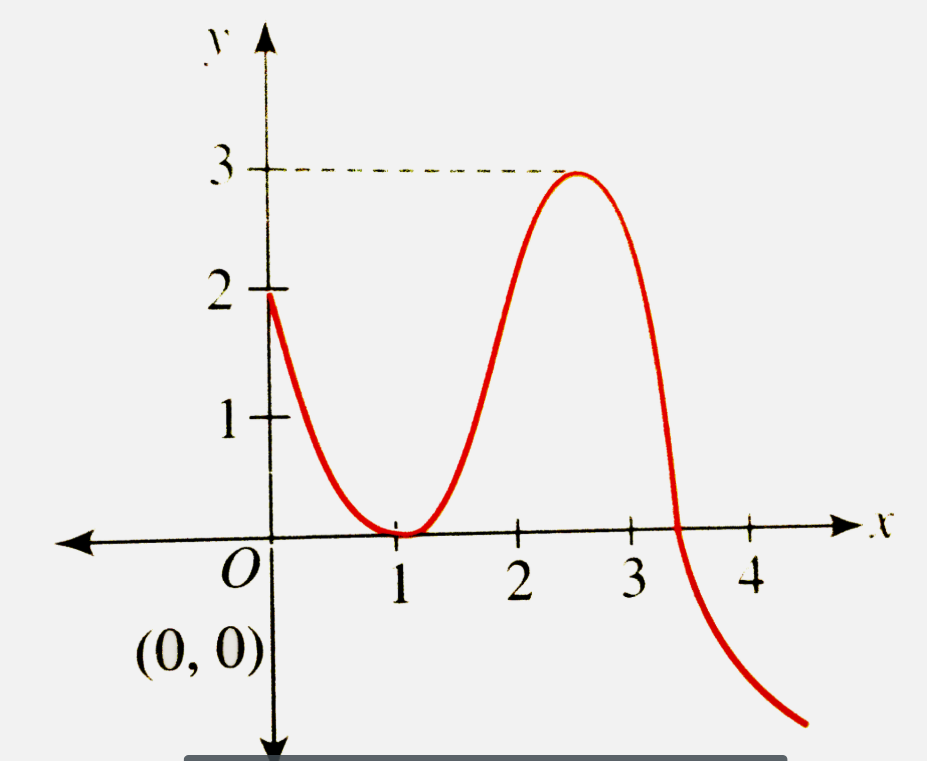Let the tangent to the graph of y=f(x) at the point x=a be parallel to the x-axis and let f'(a−h)>0andf(a+h)<0, where h is a very small positive number.Then, the ordinate of the points is
a maximum
a maximum
both a maximum and a mimum
neither a maximum nor a minimum
The correct Answer is:A
We have
f(a−it)>0
⇒ f(x) is increasing in the left neighbourhood of =a
f(a+h)<0
⇒ f(x) is decreasing in the right neigh bourhood of x=a
∴ f(a) is a local maximum value of f(x)
Topper's Solved these Questions
- MAXIMA AND MINIMA BOOK - OBJECTIVE RD SHARMA ENGLISHCHAPTER - MAXIMA AND MINIMA EXERCISE - Section I - Solved Mcqs
72 Videos
- MAXIMA AND MINIMA BOOK - OBJECTIVE RD SHARMA ENGLISHCHAPTER - MAXIMA AND MINIMA EXERCISE - Section II - Assertion Reason Type
7 Videos
- MATHEMATICAL REASONING BOOK - OBJECTIVE RD SHARMA ENGLISHCHAPTER - MATHEMATICAL REASONING EXERCISE - Chapter Test
20 Videos
- MEASURES OF CENTRAL TENDENCYBOOK - OBJECTIVE RD SHARMA ENGLISHCHAPTER - MEASURES OF CENTRAL TENDENCYEXERCISE - Chapter Test
21 Videos
Similar Questions
If the tangent to the curve y = f(x) at the point (x, y) is parallel to the x-axis, then dydx is
View SolutionIf the tangent line at a point (x, y) on the curve y=f(x) is parallel to y-axis, find the value of dxdy .
View SolutionIf the tangent line at a point (x, y) on the curve y=f(x) is parallel to x-axis, then write the value of dydx .
View SolutionLet S be the set of all values of x for which the tangent to the curve y=f(x)=x3−x2−2x at (x,y) is parallel to the line segment joining the points (1,f(1)) and (−1,f(−1)), then S is equal to :
View SolutionThe diagram shows the graph of the derivative of a functin f(x) for 0≤x≤4 with f(0) = 0. Which of the following could be correct statements for y = f(x)?

(a) Tangent line to y = f(x) at x = 0 makes an angle of sec−1√5 with the x - axis.
(b) f is increasing in (0, 3).
(c) x = 1 is both an inflection point and the point of local extremum.
(d) Number of critical point on y = f(x) is two.
View SolutionLet f(x)=11+x2, let m be the slope, a be the x-intercept and b be they y-intercept of a tangent to y=f(x).
Absicca of the point of contact of the tangent for which m is greatest, is
View SolutionLeft hand derivative and right hand derivative of a function f(x) at a point x=a are defined as
f'(a−)=limh→0+f(a)−f(a−h)h
=limh→0+f(a+h)−f(a)h
andf'(a+)=limh→0+f(a+h)−f(a)h
=limh→0+f(a)−f(a+h)h
=limh→0+f(a)−f(x)a−x respectively.
Let f be a twice differentiable function. We also know that derivative of a even function is odd function and derivative of an odd function is even function.
If f is even function, which of the following is right hand derivative of f' at x=a?
View SolutionLet f(x) have a point of inflection at x=1 and let f(x)=x. If f′(1)=0, then f(x) is equal to
View SolutionLet f(x)=x2+bx+c∀∈R,(b,c,∈R) attains its least value at x=−1 and the graph of f(x) cuts y-axis at y=2.
The value of f(−2)+f(0)+f(1)=
View SolutionLet [x] denote the integral part of x∈Randg(x)=x−[x]. Let f(x) be any continuous function with f(0)=f(1) then the function h(x)=f(g(x) :
View Solution